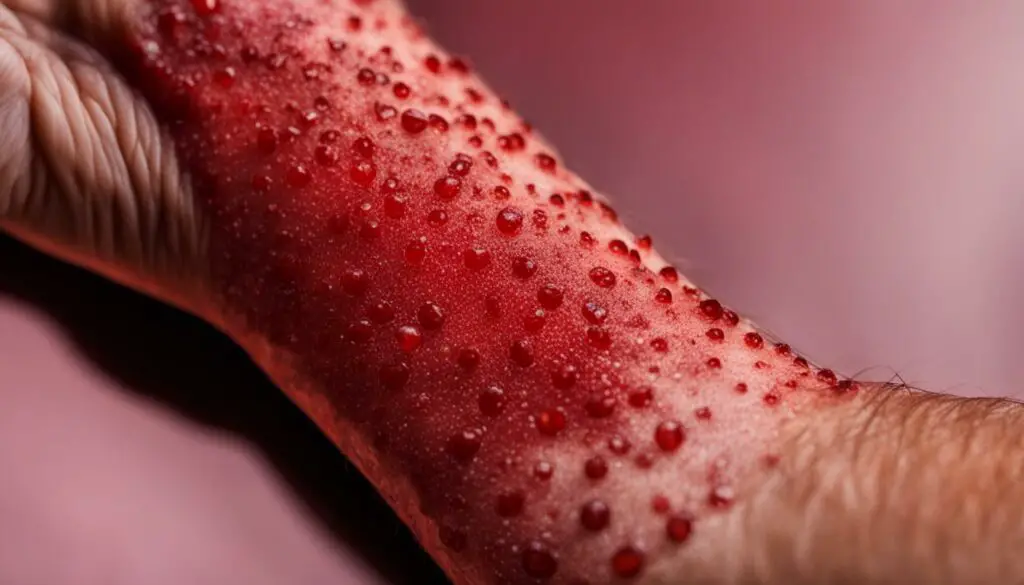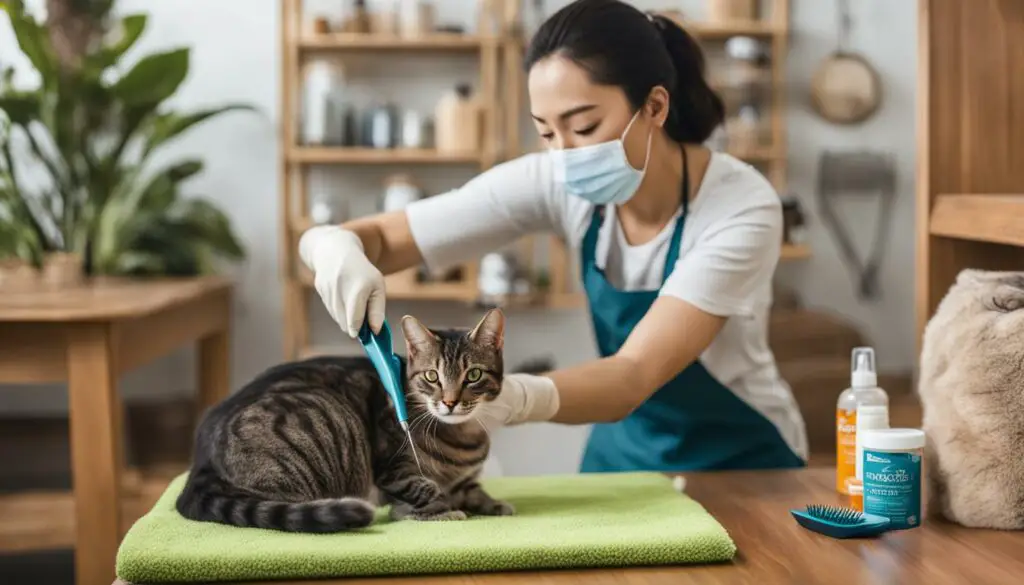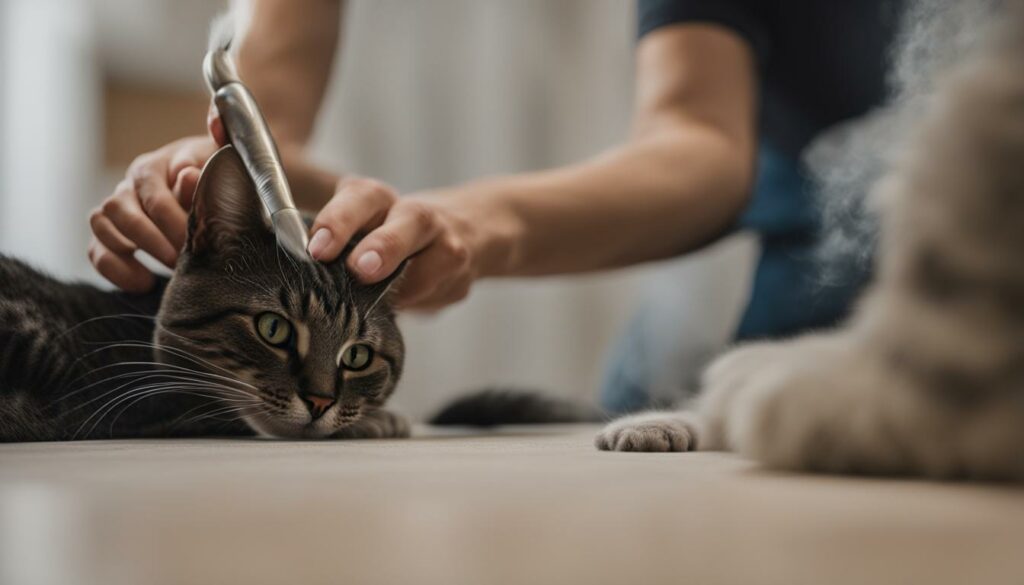Are you considering getting a domestic shorthair cat but concerned about allergies? As a cat lover and journalist, I’ve delved into the topic of hypoallergenic cats to provide you with the information you need. In this article, we’ll explore whether domestic shorthair cats are hypoallergenic, understand cat allergies, and discover how to manage allergies effectively.
Let’s start by addressing the main question: are domestic shorthair cats hypoallergenic? The answer is not straightforward. While domestic shorthair cats do not belong to a specific breed and have mixed ancestry, some individuals may have a lower probability of triggering allergies than others. However, it’s important to note that no cat is completely hypoallergenic. Even short-haired cats can shed, produce dander, and release proteins that can potentially trigger allergies in sensitive individuals.
Key Takeaways:
- Domestic shorthair cats are not a specific breed, but rather a term used to describe local shorthaired cats of mixed ancestry.
- While some domestic shorthair cats may have a lower probability of triggering allergies, no cat is 100% hypoallergenic.
- Cat allergies are caused by the Fel d1 protein found in cat dander, saliva, and urine.
- Managing cat allergies involves proper grooming, creating a hypoallergenic environment, and minimizing allergen exposure.
- Individual sensitivities to cat allergens can vary, and finding the right balance between cat ownership and allergies is important.
What to Know About Domestic Shorthair Cats
Domestic Shorthair cats are one of the most popular cat breeds worldwide. They are known for their intelligence and sharp memory. However, DSH cats are not a specific breed but rather a term used to describe local shorthaired cats of mixed ancestry. This mixed ancestry makes it difficult to determine if the cat will be hypoallergenic or not. Different DSH cats can have different levels of allergens, shedding, and dander production.
Although Domestic Shorthair cats are not considered hypoallergenic, they can still be a suitable choice for individuals with mild cat allergies. These cats are generally low shedding, which means they produce less loose hair and dander compared to some other cat breeds. However, it’s important to note that all cats, including DSH cats, produce the allergen protein Fel d1, which can trigger allergies in sensitive individuals.
To manage cat allergies with a Domestic Shorthair cat, regular grooming is essential. Brushing the cat’s coat helps to remove loose hair and reduce allergen exposure. Additionally, creating a hypoallergenic environment can help minimize allergic reactions. This includes using air purifiers with HEPA filters to remove allergens from the air and regularly cleaning surfaces to control dander. Taking these precautions can make living with a Domestic Shorthair cat more comfortable for individuals with cat allergies.
Understanding Hypoallergenic Score for Domestic Shorthair Cats
When it comes to determining the hypoallergenic nature of Domestic Shorthair cats, it is important to understand their hypoallergenic score. The hypoallergenic score for Domestic Shorthair cats is 5 out of 10, indicating a moderate probability of triggering allergies in sensitive individuals. While they are not completely hypoallergenic, they have a lower likelihood of causing allergies compared to some other cat breeds. However, it is essential to remember that all cats, regardless of breed, can potentially cause allergies in people with pet sensitivities.
Allergies associated with cats primarily involve breathing and skin sensitivities. Domestic Shorthair cats have a moderate score of 3 out of 10 for triggering breathing allergies, influenced by factors such as shedding, dander production, and the release of airborne particles. On the other hand, they have a higher score of 7.5 out of 10 for triggering skin allergies. This is primarily due to the presence of Fel d1 proteins found in their dander, saliva, urine, and other substances produced by the cat.
It is important to note that hypoallergenic scores may vary among individual cats, even within the same breed or type. Each cat may produce different levels of allergens and may have varying effects on individuals with pet sensitivities. Therefore, it is recommended to spend time with a Domestic Shorthair cat before bringing one into your home to gauge your individual allergic response.
To get a better understanding of the hypoallergenic score for Domestic Shorthair cats, refer to the table below:
| Allergy Type | Hypoallergenic Score |
|---|---|
| Breathing Allergies | 3 out of 10 |
| Skin Allergies | 7.5 out of 10 |
Shedding Levels and Hair Length of Domestic Shorthair Cats
When it comes to shedding, Domestic Shorthair cats are considered to be low shedding pets. While their coat thickness may vary depending on the season, overall, they shed moderately. It’s essential to note that even though they are short-haired cats, their shedding might not be immediately noticeable. Regular grooming can help manage their shedding levels and reduce the release of allergens that may be trapped in their fur.
Proper grooming practices, such as brushing your Domestic Shorthair cat’s coat, can significantly reduce shedding by removing loose hairs. This not only keeps your cat’s fur looking neat but also helps minimize the amount of hair that ends up on your furniture and clothing. Regular grooming sessions also provide an opportunity for you to check for any skin issues or abnormalities on your cat’s body.
While grooming is essential for managing shedding, it’s important to consider other factors that may contribute to cat allergens. Dander, which is composed of tiny flecks of dead skin and can trigger allergic reactions in some individuals, is a common concern. Regular bathing may not be necessary for most cats, but ensuring a clean environment and keeping your cat’s litter area clean can help minimize dander accumulation. Additionally, maintaining a healthy diet and providing ample exercise for your cat can contribute to healthier skin and fur, reducing shedding and potential allergens.

Overall, while Domestic Shorthair cats may shed moderately, proper grooming practices and maintaining a clean environment can go a long way in managing shedding levels and reducing the release of cat allergens into your home.
Considering Breathing Allergies and Skin Allergies
When it comes to cat allergies, two common types of reactions are breathing allergies and skin allergies. Breathing allergies refer to the respiratory symptoms that can be triggered by exposure to cat allergens, such as sneezing, coughing, and difficulty breathing. On the other hand, skin allergies manifest as skin irritation, itching, and hives when in contact with cat allergens.
For individuals with breathing allergies, the probability of Domestic Shorthair cats triggering such symptoms is rated at 3 out of 10. This is influenced by factors such as shedding, dander production, and the release of airborne particles that can be inhaled. It’s important for those with breathing allergies to take precautions and create a hypoallergenic environment to minimize exposure to cat allergens.
As for skin allergies, the probability of triggering such symptoms when in contact with Domestic Shorthair cats is rated at 7.5 out of 10. This is primarily due to the presence of Fel d1 proteins found in cat dander, saliva, urine, and other substances produced by the cat. Individuals with skin sensitivities should be mindful of their contact with the cat and practice good hygiene, such as washing hands after petting.

While Domestic Shorthair cats may not be completely hypoallergenic, understanding the specific allergies they can trigger can help individuals make informed decisions about cat ownership and manage their allergy symptoms effectively.
Maintaining Grooming and Hypoallergenic Practices with Domestic Shorthair Cats
When it comes to owning a Domestic Shorthair cat and managing allergies, proper grooming and hypoallergenic practices are essential. While DSH cats are known for their low maintenance needs, it is still important to take steps to reduce allergen exposure and minimize allergic reactions.
Regular grooming is key to managing cat allergies. Brushing your cat’s coat regularly with a stainless steel or rubber brush can help remove loose hair and reduce the amount of allergens trapped in their fur. This can significantly decrease allergic reactions for individuals with sensitivities. However, it’s important to note that excessive bathing is not necessary and can actually strip the cat’s natural oils, leading to skin problems.
Aside from grooming, it’s crucial to practice hypoallergenic habits to create a more allergy-friendly environment. This includes washing your hands after petting your cat to minimize allergen transfer and avoiding touching your face before washing your hands. Additionally, keeping the cat’s living area clean and free from excessive dust or clutter can help reduce allergen buildup.
Remember, every individual’s sensitivity to cat allergens can vary, so it’s important to find the right balance between enjoying the companionship of a Domestic Shorthair cat and managing allergies effectively. By implementing proper grooming techniques and hypoallergenic practices, you can create a more comfortable environment for both you and your feline friend.

Managing Allergies with Domestic Shorthair Cats
If you or someone in your household has allergies but still wants to have a Domestic Shorthair cat, there are some tips to help minimize allergic reactions. First, consider training the cat to stay away from certain areas of your home, such as your bedroom or furniture where you spend a lot of time. This can help reduce your exposure to allergens.
Another helpful strategy is to use allergy-combating devices like air purifiers with HEPA filters. These filters can remove allergens from the air, making it cleaner and safer for individuals with allergies. Additionally, regular vacuuming of your home can help remove cat hair and dander, further reducing allergen exposure.
When it comes to cleaning products, opt for allergy-friendly options that are specifically designed to minimize allergens. These products are formulated to reduce the presence of allergens on surfaces, helping to create a more hypoallergenic environment for you and your cat.
Lastly, consider keeping your bedroom off-limits to the cat. This can help create a space where you can retreat to and have a break from allergens. Keeping your sleeping area free from cat hair and dander can greatly improve your quality of sleep and overall well-being.

Tips for Managing Allergies with Domestic Shorthair Cats
- Train the cat to stay away from certain areas of your home.
- Use air purifiers with HEPA filters to remove allergens from the air.
- Regularly vacuum your home to remove cat hair and dander.
- Use allergy-friendly cleaning products to minimize allergen presence.
- Keep your bedroom off-limits to the cat to create an allergen-free space.
By implementing these tips, you can create a more allergy-friendly environment while still enjoying the company of a Domestic Shorthair cat. Remember, managing allergies is a personalized process, so it’s important to consult with a healthcare professional for additional guidance and support.
| Tips for Managing Allergies with Domestic Shorthair Cats |
|---|
| Train the cat to stay away from certain areas of your home. |
| Use air purifiers with HEPA filters to remove allergens from the air. |
| Regularly vacuum your home to remove cat hair and dander. |
| Use allergy-friendly cleaning products to minimize allergen presence. |
| Keep your bedroom off-limits to the cat to create an allergen-free space. |
The Myth of Hypoallergenic Cats
When it comes to hypoallergenic cats, there is a common misconception that certain breeds, like the Domestic Shorthair, are completely free from allergens. However, this is far from the truth. All cats, including Domestic Shorthair cats, produce the allergen protein Fel d1, which can trigger allergic reactions in sensitive individuals. The length of a cat’s hair also does not determine its hypoallergenic nature, as even short-haired cats can carry the allergen protein.
To debunk the myth of hypoallergenic cats, it’s essential to understand that the term “domestic shorthair” refers to cats of mixed ancestry and does not guarantee a lower allergenicity. While some cat breeds are marketed as hypoallergenic, no cat breed is truly hypoallergenic. Domestic Shorthair cats are of mixed heritage, making it difficult to predict their allergen production. The idea of a hypoallergenic cat is simply a marketing ploy.

It’s important to note that individual sensitivities to cat allergens can vary. Some people may have milder reactions to Domestic Shorthair cats compared to other breeds, but it’s crucial to manage cat allergies regardless. Practicing regular grooming, creating a hypoallergenic environment, and taking necessary precautions can help minimize allergic reactions and make living with a cat more manageable for individuals with allergies.
Understanding Cat Allergies and Symptoms
Cat allergies occur when the immune system reacts to the Fel d1 protein, which is present in cat dander, saliva, and urine. These allergens can trigger various symptoms, including rhinitis (a runny or stuffy nose), sneezing, watery eyes, coughing, asthma, and skin reactions like dermatitis and hives. It’s important to differentiate cat allergies from other types of allergies, such as those caused by house dust, tobacco smoke, molds, or other substances.
The allergic response to cat allergens can vary in severity from person to person. Some individuals may experience mild symptoms, while others may have more severe reactions. For example, individuals with asthma may be more prone to experiencing asthma attacks triggered by cat allergens. It’s crucial to be aware of these symptoms and seek appropriate management methods to alleviate discomfort and prevent complications.
“I always knew I had cat allergies, but it wasn’t until I adopted a Domestic Shorthair cat that I truly understood the extent of my sensitivities. The sneezing and itchy eyes became a daily struggle, but with proper management and understanding, I was able to find a balance between my love for cats and my allergies.”

“Living with cat allergies can be challenging, but it doesn’t mean you have to give up on your feline companions. Understanding the symptoms and taking steps to manage your allergies can help you coexist with your beloved cat in a comfortable and safe environment.”
H3: How to minimize cat allergy symptoms
If you have cat allergies but still want to enjoy the company of a cat, there are several measures you can take to minimize your symptoms:
- Keep your cat out of your bedroom to create a cat-free sanctuary where you can sleep without allergen exposure.
- Use air purifiers and HEPA filters to remove cat dander and other allergens from the air.
- Vacuum regularly with a vacuum cleaner equipped with a pet attachment to eliminate loose cat hair and dander.
- Wash your hands after petting your cat to reduce the transfer of allergens to your face and body.
- Consider using allergy medications or antihistamines to alleviate symptoms, but consult with a healthcare professional before starting any medication regimen.
By implementing these strategies, you can create a more allergy-friendly environment and enjoy the companionship of your cat while minimizing the impact of cat allergies on your daily life.
| Cat Allergy Symptoms | Rhinitis | Sneezing | Watery Eyes | Coughing | Asthma | Skin Reactions |
|---|---|---|---|---|---|---|
| Probability | 8 out of 10 | 9 out of 10 | 7 out of 10 | 6 out of 10 | 8.5 out of 10 | 7.5 out of 10 |
Confirming Cat Allergies
If you suspect you have cat allergies, it is recommended to get an allergy screen or blood test to confirm the presence of cat allergens. These tests involve exposing the skin to small amounts of suspected allergens and observing any allergic reaction. Blood tests can also identify specific allergens. It is important to diagnose cat allergies accurately to ensure appropriate management.
Allergy Testing Options
When it comes to confirming cat allergies, there are two main testing options available: allergy screens and blood tests. Allergy screens, also known as skin prick tests, involve introducing small amounts of potential allergens into the skin and monitoring for any negative reactions. This method can help identify the specific triggers causing the allergic response, including cat allergens.
Another option is a blood test which measures the presence of specific antibodies in the blood. This can provide a comprehensive overview of the allergens to which an individual may be sensitive. Blood tests can be particularly helpful in identifying allergens that are difficult to detect through skin tests.
“Confirming cat allergies through testing is essential to understanding the specific triggers and developing an effective management plan.”
– Dr. Emily Carter, Allergy Specialist
| Allergy Testing Options | |
|---|---|
| Allergy Screen (Skin Prick Test) | Blood Test |
| Introduces small amounts of allergens into the skin to observe reactions | Measures specific antibodies in the blood to identify allergens |
| Helpful in identifying immediate allergic reactions | Provides a comprehensive overview of allergens |
| May not detect all allergens | Can detect allergens that are difficult to identify through skin tests |

Confirming cat allergies through testing is essential to understanding the specific triggers and developing an effective management plan. By identifying the presence of cat allergens, individuals can take proactive measures to reduce exposure and alleviate symptoms.
Managing Cat Allergies
When it comes to managing cat allergies, there are several strategies that can help minimize allergic reactions and improve overall comfort. Two common approaches are using antihistamines and allergy medications, and controlling allergen exposure through dander control.
Antihistamines and Allergy Medications
Antihistamines are a popular choice for managing cat allergies as they can help reduce symptoms such as sneezing, itching, and watery eyes. There are numerous over-the-counter antihistamines available, including cetirizine, loratadine, and fexofenadine. However, it is important to consult a healthcare professional or pharmacist before starting any medication to ensure it is safe and suitable for your specific needs.
Allergy medications, such as nasal sprays and eye drops, can also provide relief from cat allergy symptoms. These medications work by reducing inflammation in the nasal passages and eyes, alleviating congestion and itchiness. Again, it is recommended to seek medical advice before using any new medication.
Allergen Exposure and Dander Control
To minimize allergen exposure, it is essential to practice proper dander control. Regular grooming is key, as it helps remove loose fur and dander from your cat’s coat. Brushing your cat daily can significantly reduce the amount of allergens present in your home. You should also consider bathing your cat regularly using a hypoallergenic shampoo specifically designed for pets.
Other measures to control dander include vacuuming regularly with a machine that has a HEPA filter to trap allergens, using allergen-proof bedding covers, and washing your hands immediately after petting or playing with your cat. Keeping the bedroom off-limits to your cat can also help create a cat-free sanctuary where you can find relief from allergies.

Overall, managing cat allergies involves a combination of medication, allergen avoidance, and proper dander control. By implementing these strategies, individuals with cat allergies can enjoy the companionship of their feline friends while minimizing discomfort and allergic reactions.
The Reality of Shedding in Domestic Shorthair Cats
When considering owning a Domestic Shorthair cat, it’s important to understand the reality of shedding. While Domestic Shorthair cats are known for being low shedding cats compared to some other breeds, they still shed moderately. Shedding is a natural process for all cats, including DSH cats, as their hair grows continuously. The shedding process is necessary to make room for new hair growth. Regular grooming can help manage shedding and reduce the amount of loose hair in your home.
Grooming plays a vital role in maintaining a healthy coat and minimizing shedding. Regular brushing helps remove loose hair and redistributes natural oils throughout the cat’s coat, promoting a healthy shine. It also helps prevent matting, which can be uncomfortable for the cat. Additionally, grooming provides an excellent opportunity to bond with your cat and keep an eye on their overall health. When grooming your Domestic Shorthair cat, use a stainless steel or rubber brush that suits their coat type and follow a gentle brushing technique to avoid causing any discomfort.
While shedding is a natural part of owning any cat, including Domestic Shorthair cats, there are some measures you can take to manage shedding and minimize the amount of loose hair in your home. Regular vacuuming, especially with a pet attachment, helps remove loose hair from carpets, upholstery, and other surfaces. This is particularly important for individuals with allergies, as loose hair can contain allergens. Additionally, maintaining a clean living environment and using allergy-friendly cleaning products can help reduce allergens in the air and on surfaces.

In summary, Domestic Shorthair cats are not exempt from shedding, but they are considered low shedding cats. Regular grooming, including brushing and maintaining a healthy coat, can help manage shedding and reduce the amount of loose hair in your home. Additionally, keeping your living environment clean and using allergy-friendly cleaning products can help minimize allergen exposure. While shedding is a natural process, these steps can make living with a Domestic Shorthair cat more enjoyable for both you and your feline companion.
Creating a Hypoallergenic Environment
When it comes to living with cat allergies, creating a hypoallergenic environment can greatly reduce allergen exposure and minimize symptoms. Here are some tips to help you maintain a cat-friendly yet allergy-friendly living space:
- Invest in an air purifier with a HEPA filter: An air purifier can help remove allergens, including cat dander, from the air, making it easier for individuals with allergies to breathe. Place the air purifier in the rooms where you and your cat spend the most time.
- Regular cleaning is key: Vacuum regularly with a vacuum cleaner that has a pet attachment to effectively remove cat hair and dander from carpets and upholstery. Use allergy-friendly cleaning products to wipe down surfaces and reduce allergen build-up.
- Minimize textiles and soft furnishings: Fabrics can trap allergens, so opt for hardwood or tiled floors instead of carpets, and choose blinds or washable curtains over heavy drapes. Consider using allergen-proof covers for mattresses and pillows to reduce exposure while sleeping.
- Designate cat-free zones: Keep your bedroom off-limits to your cat to create a sanctuary where you can sleep without allergen exposure. Use baby gates or cat doors to restrict access to certain areas of your home, such as the living room or kitchen.
By implementing these practices, you can create a hypoallergenic environment that allows you to enjoy the companionship of your Domestic Shorthair cat while minimizing the impact of allergens on your health.
“Creating a hypoallergenic environment is crucial for individuals with cat allergies. By investing in an air purifier, maintaining a clean living space, minimizing textiles, and setting boundaries for your cat, you can significantly reduce allergen exposure and create a more allergy-friendly home.” – Cat Allergy Expert
| Tip | Description |
|---|---|
| Air Purifier | Invest in an air purifier with a HEPA filter to remove allergens from the air. |
| Regular Cleaning | Vacuum regularly and use allergy-friendly cleaning products to minimize allergen build-up. |
| Minimize Textiles | Opt for hardwood or tiled floors and use washable curtains to reduce allergen trapping. |
| Cat-Free Zones | Designate certain areas of your home as cat-free zones, such as the bedroom. |

Remember, while these strategies can help minimize the impact of cat allergens, they are not a substitute for proper management of cat allergies. If your symptoms persist or worsen, consult with a healthcare professional for further guidance and treatment options.
The Quest for a Truly Hypoallergenic Cat Breed
As cat lovers with allergies continue to search for a hypoallergenic solution, the quest for a truly hypoallergenic cat breed has gained momentum. With advancements in genetic engineering and cat breeding, there is hope that a cat with reduced allergenic properties can be created. However, it is essential to understand the challenges and limitations associated with this goal.
Genetic engineering offers the possibility of altering cat genes to minimize the production of the Fel d1 protein, the primary allergen found in cat dander. This protein is responsible for triggering allergic reactions in sensitive individuals. By modifying the genes responsible for producing Fel d1, scientists aim to create cats with lower allergenicity.
While genetic engineering shows promise, it is not without controversy. Ethical concerns arise regarding the manipulation of animals’ genetic makeup for human convenience. Additionally, achieving a truly hypoallergenic cat breed through selective breeding or genetic engineering is a complex and challenging process. It requires careful consideration of the cat’s overall health, temperament, and natural instincts.
| Pros | Cons |
|---|---|
| Offers hope for individuals with severe cat allergies | Ethical concerns regarding genetic manipulation |
| Potentially reduces allergen exposure for sensitive individuals | Complex and challenging process |
| May increase the availability of hypoallergenic cats | No guarantee of success or widespread availability |
While the quest for a truly hypoallergenic cat breed continues, it is essential to remember that managing cat allergies involves more than just finding the perfect breed. Proper grooming, creating a hypoallergenic environment, and managing allergen exposure are crucial steps in minimizing allergic reactions. Additionally, consulting with a healthcare professional, allergist, or veterinarian can provide tailored advice and guidance based on individual needs.
Conclusion
In summary, while Domestic Shorthair cats are not considered hypoallergenic, they can still be a suitable choice for individuals with mild allergies. Their moderate shedding, lower dander production, and allergen exposure make them more tolerable for sensitive individuals compared to other cat breeds. However, it is important to manage cat allergies properly to ensure a harmonious coexistence with your feline friend.
Managing cat allergies involves practicing proper grooming techniques, creating a hypoallergenic environment, and taking necessary precautions. Regular brushing and grooming can help reduce shedding and control the release of allergens trapped in the cat’s fur. Using air purifiers with HEPA filters and keeping your home clean can also minimize allergen exposure. Additionally, maintaining good hygiene by washing hands after petting the cat is essential to prevent allergic reactions.
Although the quest for a truly hypoallergenic cat breed continues, in the meantime, Domestic Shorthair cats can provide companionship to individuals with mild allergies. It’s important to remember that each person’s sensitivity to cat allergens can vary, so it’s essential to find the right balance between cat ownership and managing allergies for your specific needs.
Ultimately, the decision to own a Domestic Shorthair cat should be based on your comfort level with managing allergies. With proper care and allergen control, you can enjoy the company of these intelligent and unique cats while minimizing allergic reactions.
FAQ
Are Domestic Shorthair Cats hypoallergenic?
While no cat is 100% hypoallergenic, some Domestic Shorthair cats have a lower probability of triggering allergies than others. Their hypoallergenic nature can vary due to their mixed ancestry and genetic makeup.
What is the shedding level of Domestic Shorthair Cats?
Domestic Shorthair cats are considered low shedding cats. While they still shed moderately, regular grooming and brushing can help manage their shedding levels and reduce allergen exposure.
How can I manage allergies with a Domestic Shorthair Cat?
To minimize allergic reactions, you can train the cat to stay away from certain areas, use allergy-combating devices like air purifiers and HEPA filters, regularly groom the cat, and keep the bedroom off-limits to the cat.
Are there hypoallergenic cat breeds?
No cat breed is truly hypoallergenic. All cats, including Domestic Shorthair cats, produce the allergen protein Fel d1, which can trigger allergies in sensitive individuals.
What are the symptoms of cat allergies?
Symptoms of cat allergies can include rhinitis (runny nose), sneezing, watery eyes, coughing, asthma, and skin reactions like dermatitis and hives.
How can I confirm if I have cat allergies?
It is recommended to get an allergy screen or blood test to confirm the presence of cat allergens. These tests involve exposing the skin to small amounts of suspected allergens and observing any allergic reaction.
How can I manage cat allergies?
Cat allergies can be managed by taking antihistamines to reduce symptoms, reducing allergen exposure through grooming and cleaning practices, and creating a hypoallergenic environment with air purifiers and allergen control measures.
Do Domestic Shorthair Cats shed a lot?
Domestic Shorthair cats are low shedding compared to some other breeds, but they still shed moderately. Regular grooming and maintenance can help manage shedding and reduce loose hair in your home.
How can I create a hypoallergenic environment?
To create a hypoallergenic environment, you can use air purifiers with HEPA filters, regularly clean and vacuum to control dander, and minimize soft furnishings and textile surfaces that can trap cat allergens.
Are there truly hypoallergenic cat breeds?
Despite attempts to breed hypoallergenic cat breeds, no truly hypoallergenic cat breed exists. Genetics and allergen production in cats are complex, and finding the perfect hypoallergenic cat remains elusive.








